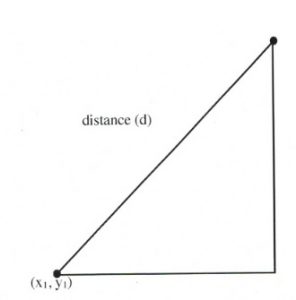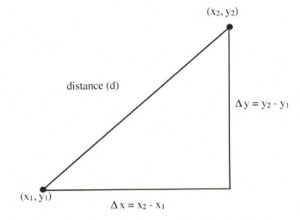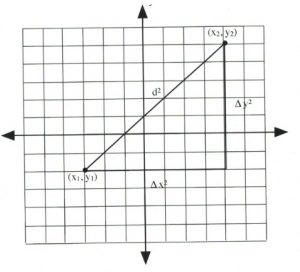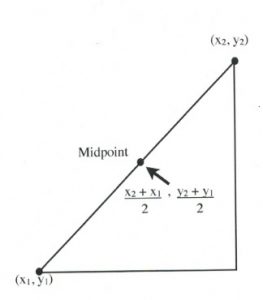17 3.2 Midpoint and Distance Between Points
Finding the Distance Between Two Points
The logic used to find the distance between two data points on a graph involves the construction of a right triangle using the two data points and the Pythagorean theorem \((a^2 + b^2 = c^2)\) to find the distance.
To do this for the two data points \((x_1, y_1)\) and \((x_2, y_2)\), the distance between these two points \((d)\) will be found using \(\Delta x = x_2 - x_1\) and \(\Delta y = y_2 - y_1.\)
Using the Pythagorean theorem, this will end up looking like:
\(d^2 = \Delta x^2 + \Delta y^2\)

or, in expanded form:
\(d^2 = (x_2 - x_1)^2 + (y_2 - y_1)^2\)

On graph paper, this looks like the following. For this illustration, both \(\Delta x\) and \(\Delta y\) are 7 units long, making the distance \(d^2 = 7^2 + 7^2\) or \(d^2 = 98\).

The square root of 98 is approximately 9.899 units long.
Example 3.2.1
Find the distance between the points \((-6,-4)\) and \((6, 5)\).
Start by identifying which are the two data points \((x_1, y_1)\) and \((x_2, y_2)\). Let \((x_1, y_1)\) be \((-6,-4)\) and \((x_2, y_2)\) be \((6, 5)\).
Now:
\(\Delta x^2 = (x_2 - x_1)^2\) or \([6 - (-6)]^2\) and \(\Delta y^2 = (y_2 - y_1)^2\) or \([5 - (-4)]^2\).
This means that
\(d^2 = [6 - (-6)]^2 + [5 - (-4)]^2\)
or
\(d^2 = [12]^2 + [9]^2\)
which reduces to
\(d^2 = 144 + 81\)
or
\(d^2 = 225\)
Taking the square root, the result is \(d = 15\).
Finding the Midway Between Two Points (Midpoint)
The logic used to find the midpoint between two data points \((x_1, y_1)\) and \((x_2, y_2)\) on a graph involves finding the average values of the \(x\) data points \((x_1, x_2)\) and the of the \(y\) data points \((y_1, y_2)\). The averages are found by adding both data points together and dividing them by \(2\).
In an equation, this looks like:
\(x_{\text{mid}}=\dfrac{x_2+x_1}{2}\) and \(y_{\text{mid}}=\dfrac{y_2+y_1}{2}\)
Example 3.2.2
Find the midpoint between the points \((-2, 3)\) and \((6, 9)\).

We start by adding the two \(x\) data points \((x_1 + x_2)\) and then dividing this result by 2.
\(x_{\text{mid}} = \dfrac{(-2 + 6)}{2}\)
or
\(\dfrac{4}{2} = 2\)
The midpoint's \(y\)-coordinate is found by adding the two \(y\) data points \((y_1 + y_2)\) and then dividing this result by 2.
\(y_{\text{mid}} = \dfrac{(9 + 3)}{2}\)
or
\(\dfrac{12}{2} = 6\)
The midpoint between the points \((-2, 3)\) and \((6, 9)\) is at the data point \((2, 6)\).
Questions
For questions 1 to 8, find the distance between the points.
- (−6, −1) and (6, 4)
- (1, −4) and (5, −1)
- (−5, −1) and (3, 5)
- (6, −4) and (12, 4)
- (−8, −2) and (4, 3)
- (3, −2) and (7, 1)
- (−10, −6) and (−2, 0)
- (8, −2) and (14, 6)
For questions 9 to 16, find the midpoint between the points.
- (−6, −1) and (6, 5)
- (1, −4) and (5, −2)
- (−5, −1) and (3, 5)
- (6, −4) and (12, 4)
- (−8, −1) and (6, 7)
- (1, −6) and (3, −2)
- (−7, −1) and (3, 9)
- (2, −2) and (12, 4)

